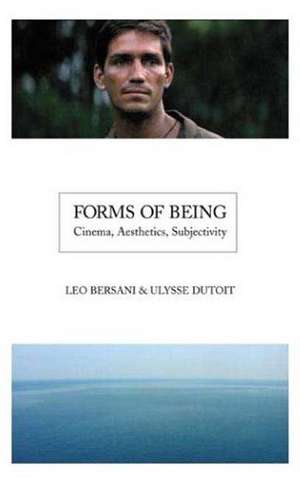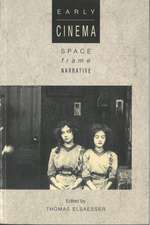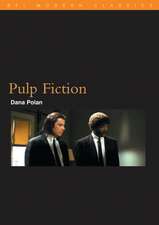Forms of Being: Cinema, Aesthetics, Subjectivity
Autor Leo Bersani, Ulysse Dutoiten Limba Engleză Hardback – 2 iul 2004
Preț: 597.70 lei
Preț vechi: 695.01 lei
-14% Nou
Puncte Express: 897
Preț estimativ în valută:
114.37€ • 119.71$ • 95.19£
114.37€ • 119.71$ • 95.19£
Carte disponibilă
Livrare economică 10-24 martie
Preluare comenzi: 021 569.72.76
Specificații
ISBN-13: 9781844570157
ISBN-10: 1844570150
Pagini: 185
Dimensiuni: 138 x 216 x 19 mm
Greutate: 0.48 kg
Ediția:2004
Editura: British Film Institute
Colecția British Film Institute
Locul publicării:London, United Kingdom
ISBN-10: 1844570150
Pagini: 185
Dimensiuni: 138 x 216 x 19 mm
Greutate: 0.48 kg
Ediția:2004
Editura: British Film Institute
Colecția British Film Institute
Locul publicării:London, United Kingdom
Textul de pe ultima copertă
In
each
of
the
films
discussed
in
this
book
-
"Le
Mepris"
(Jean-Luc
Godard,
1963),
"All
About
My
Mother"
(Pedro
Almodovar,
1999),
"The
Thin
Red
Line"
(Terrence
Malick,
1998)
-
something
extraordinary
is
proposed.
Or
if
not
proposed,
then
shown,
visually,
by
stranger
and
more
powerful
means
than
narrative
or
argument.
It
is
a
matter
in
every
case
of
re-imagining
the
relationship
between
subjectivity
and
the
world.
At
the
end
of
"Le
Mepris"
a
conventional
account
of
doomed
and
tragic
love
is
displaced
by
images
of
nature
as
just
a
space
of
almost
blank
appearances,
which
are
beyond
all
human
desire
and
psychological
entanglements.
"All
About
My
Mother
"veers
away
from
imprisoning
forms
of
identity,
family
and
gender.
It
begins,
hesitantly,
to
depict
other
kinds
of
sociability
-
more
fluid
ones
that
do
not
rely
on
coercion
or
obligation.
Most
remarkably,
"The
Thin
Red
Line"
moves
to
eradicate
discourse
itself
-
to
approach
the
world
and
the
beings
in
it
with
a
neutral
gaze,
without
presupposing
a
hierarchy
of
relationships.
In
its
use
of
close-ups
and
in
its
patterns
of
visual
correspondence
between
human
and
non-human
life,
The
"Thin
Red
Line"
becomes
abstract
and
startlingly
indifferent
to
its
violent
subject-matter
-
as
if,
according
to
Leo
Bersani
and
Ulysse
Dutoit,
an
impassive,
wholly
receptive
looking
were
the
most
appropriate,
the
most
ethically
justifiable,
the
least
enraged
and
possessive
way
to
appreciate
the
possibilities
of
existing
in
a
world
which
is,
beyond
the
conflict
that
is
brought
into
it,
not
at
war
with
its
inhabitants.
The
close
analyses
(supported
by
numerous
illustrations)
in
"Forms
of
Being"
are
groundbreakingly
original
and
compelling,
suggesting
newways
of
approaching
cinema
as
visual
art.
Together
they
further
develop
the
authors'
longstanding
project
to
redefine
the
ways
in
which
subjectivity,
sexuality,
relationality
and
aesthetics
can
be
understood
and
transformed.










